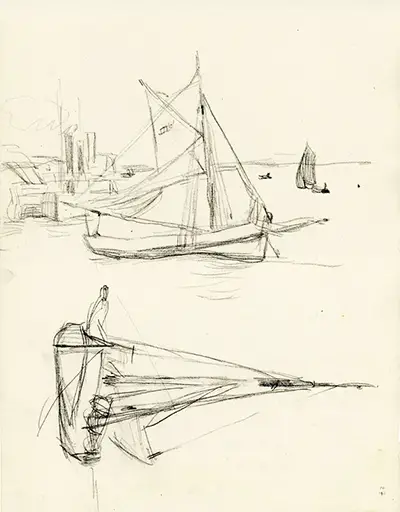Studies of Boats is a work of art that is currently held in Paris, in the Musee Marmottan. While it may just look like a rough sketch, Studies of Boats is valuable in its own right because it can tell us a lot about how Monet sketched and how he prepared for his paintings (which he executed in a variety of media including oils, gouache, and pastels).
Monet lived between 1840 and 1926 and he remains one of the world's foremost Impressionist painters.
As one can tell from the name, Studies of Boats is a series of sketches of boats. Monet created most of his works of art in situ: placing himself with his portable easel in front of whatever it was that he was painting. Thus, he was an artist who spend a considerable amount of time outdoors instead of hiding away in his studio.
It is likely, then, that Monet sketched Studies of Boats whilst he was actually sitting in front of the boats depicted in this sketch. However, he may equally have sketched them from memory, we cannot absolutely tell for certain.
Monet completed Studies of Boats in 1793, when he was already quite well advanced in his career. Indeed, just one year later in 1874, Monet would introduce the art world to the technical term 'Impressionism'. This is because in 1874 he would release what we would now call a highly impressionistic work of art whose title was Impression: Levant de Soleil.
The term 'Impression' and its cognate term 'Impressionism' have stuck ever since and have been used to describe Monet's unique style of painting, which is dreamlike, vivid, and very emotionally charged.
What is instantly remarkable to many onlookers about Studies of Boats is the way in which Monet divides the eponymous boats up into a set of strong triangles. This breaking down of objects or even the human form into distinct geometric shapes was more of a hallmark of another prominent art form that would start to develop at the beginning of the twentieth century: Cubism.
In Studies of Boats we see the boats both broken down geometrically and put back together to form a unified whole. Studies of Boats is thus interesting because - unlike the often blurred and very dynamic images that Monet creates in famous paintings such as his Waterlilies series - in this drawing the lines are clear and sharp.
Studies of Boats demonstrates that behind the dreamlike images that Monet created, there was a lot of careful draughtsmanship. Here he can be compared to any number of artists - the Expressionist painter Vincent Van Gogh, for instance, was wont to create hundreds of preliminary sketches for a single painting to ensure that he had got the form just right.


